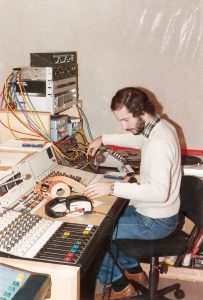Old School Voiceover… But Still Top of the Class
British novelist L.P. Hartley once wrote: ”the past is a foreign country: they do things differently there”. For a British female voiceover artist who has witnessed more than 30 years of change, I could not think of a truer statement to begin this post.
There has been seismic change in ‘Voiceoverland’ since I earned my passport to the industry, doing radio commercials in the north-west of England in the mid 1980s.
In those days, producers would train up a small number of artists, give them advice and work, and slowly nurture their careers. Not now. Today, training is an industry in itself. You can carry out your apprenticeship through online and in-person courses, you can join industry societies, and you can work with UK coaches (like me) face-to-face or via Skype, or with coaches from all over the globe.
In fact, what might have been ‘Voiceover Land’ at one time is now very much ‘Voiceover World’. It wasn’t always equally populated, either.
When I first started in radio ads, there were very few FVOs (female voiceovers) compared to men. And out of that group, there were hardly any voiceover artists in general!
Fast forward to today, and there are thousands of registered members of just one of many voiceover Facebook groups – not forgetting the many other areas of the internet where a voiceover can declare themselves available for work.
The way you worked was also vastly different. For example, Christmas in commercial radio was a very special time, because it became a gift that kept on giving. Producers would ring you up, you’d get your diary out, and you would plan your work for the next year. A trip to one radio station in one region meant that you could travel to others (or to video production companies) in the same area in the same week.
In the days before emails, websites and social media, this was how the humble voiceover artist built his or her network.
Many artists were like travelling salespeople, staying in hotels during the week and heading home on Fridays. And as in sales, before the ‘briefcase’ (and later, ‘brick’) mobile phones, artists would have to find a public phone box, ring home, and check to see if any work offers had come in.

This all might sound like hell for today’s voiceover artist who knows they can freely work in their pyjamas, but being a travelling voice for hire was an integral part of my training. I never knew what scripts I would face until I arrived at the studio. Some of the male voices could get up to 60 scripts in one session. Time was against us.
What’s more, all of us learnt how to breathe silently, so that the producer didn’t have to cut and splice the audio tape together. We perfected our timing, pitch, inflection and phrasing with every single script – all of them demanding; all of them different.
That’s why my generation of artists are all excellent sight readers and all highly adaptable. That’s also why I’m still working today.

Yesterday’s voiceover learning curve was fast, steep, intensive and a grind. I spent hours travelling, working, reading, and practising. Achieving perfection was gradual.
So perhaps you’d be surprised to learn that my first physical showreel actually took two years to make. It sits on the shelf in my office to this day.
Sadly, 21st century technology – and the instant gratification era – have meant that today’s voiceover learning curve is far too short. Demos and showreels can be made on a whim, digitally, using made-up copy or even scripts taken from the internet. You don’t even have to pay anyone to produce it. Just plug in a cheap mic into your a laptop, download a free recording software and Bob’s your uncle.
Sadder still, is that anybody – particularly people taking this route – thinks they can be a professional voiceover. It’s the kind of false logic that would make me qualified to be a plumber, because I have a tap and when I turn it, water comes out.
As much as it might be uncomfortable to hear, many of today’s voiceover artists – and even some claiming to be professionals – would not have lasted five minutes in my era.
Getting good, VERY good at something takes time. COVID didn’t help. There was a wave of people who, on their first morning waking up on furlough, believed that they were a voice artist. They were ready to make money. And that money would be easy. I can count on very few of my fingers how many of those people are still working in this industry.
And don’t get me started on those who say “I can DO loads of voices”. What I do, what I AM, is so much more than just DOING voices.
We now face the task of fighting off the AI army. The real voices that will survive this are those that can act, those that have skill and experience, those that have invested time (yes, and money) in honing their craft. We must stay a step ahead of the robots, not try and keep up with them.
The past might be a foreign country. But I wouldn’t change mine for the world.
 +44 (0) 7788 747 946
+44 (0) 7788 747 946
